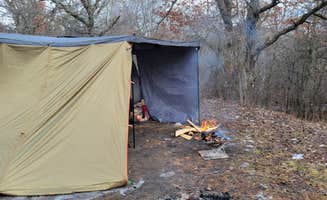Sand Dunes State Forest offers rustic camping near Mound, Minnesota approximately 60 miles northwest of the Twin Cities metropolitan area. This public forest land spans roughly 5,800 acres of mixed oak woodland and sandy pine plantations, with elevation ranging from 950-1050 feet above sea level. Vehicle access to primitive camping spots varies seasonally, with spring thaw and heavy rainfall occasionally limiting entrance to higher clearance vehicles.
What to do
Bird watching opportunities: Campers frequently note diverse birdlife throughout the forest, particularly in morning hours. "Quiet with lots of different bird sounds," reports one visitor about the South of Sand Dunes State Forest, making it ideal for casual birding.
Hammock camping setups: The mix of mature pines creates natural hammock stations throughout the forest. "I was able to walk in and find an incredible spot to camp and lay in my hammock," notes one camper who appreciates the proximity to the Twin Cities.
Vehicle-based exploration: Multiple branching forest roads allow for extended day trips from your base camp. "The road goes for a long ways, I parked near the front and closer to numbers, always like to be safer," explains one visitor, suggesting strategic site selection for those wanting more accessibility.
What campers like
Proximity to metro area: The forest's location makes it perfect for last-minute weekend escapes. "I love that it's so close to home," writes one camper who appreciates the ability to quickly access primitive camping without extensive travel time.
Quiet weekday camping: Visitor traffic patterns show significantly reduced activity midweek. "A bit more traffic, but after 12 p.m., not much of anything," reports a return visitor to Sand Dunes State Forest, indicating that afternoon arrivals encounter fewer passing vehicles.
Multiple site options: The forest road network offers various camping environments. "There's lots of little spots off the main gravel road. Nothing allowed further into the forest. One pull through area that I found," notes a camper, confirming restrictions on off-road vehicle travel.
What you should know
Wildlife awareness: Some unexpected animal encounters require caution. One camper cautions about nesting birds: "Sand storks are very protective. Stay away from them. They attack."
Varying site sizes: Most primitive spots accommodate standard vehicles with limited options for larger setups. "Great spot. Plenty of parking. Best for straight vehicles or very small trailers," advises a visitor regarding site limitations.
Road traffic concerns: Despite the remote setting, some forest roads see consistent vehicle traffic. "This road is pretty busy for a dirt forest road and people FLY down it. Almost got hit a few times walking," warns one camper, suggesting cautious pedestrian movement along main access routes.
Tips for camping with families
Low-clearance vehicle access: Most camping areas remain accessible without specialized equipment. "Roads were totally fine for any vehicle," confirms a camper, making this area suitable for family cars without off-road capabilities.
Insect preparation: Mosquitoes remain prevalent throughout warmer months. "As to be expected, mozzies were present, but after 5mins of the door being opened and several flying in, we decided the area wasn't for us," shares one family, highlighting the importance of proper insect protection.
Vehicle traffic awareness: Parents should monitor children near forest roads due to occasional fast-moving traffic. "Even through a Wednesday night cars are flying down the road," notes one camper, suggesting selecting sites further from the main access routes.
Tips from RVers
Site limitations for trailers: RV campers report mixed experiences with vehicle accommodation. "I had a county sheriff person tell me it's not lawful to park a trailer and they kicked me out. I called the DNR and they said that wasn't right but I decided to leave anyway," explains one RVer, suggesting potential confusion about trailer regulations.
Overhead clearance issues: Some sites feature low-hanging branches unsuitable for taller vehicles. "We did find one we thought we liked, but branches over hung, and rested on our camper (8ft high) and in fact most sites were shaded," reports one camper, noting physical limitations for larger rigs.
Truck camper viability: Smaller self-contained units report more success finding suitable spots. "I just did an overnight camp one night in a truck camper and it was very easy to navigate and it was cleaned quiet area to spend the night," confirms one visitor who found the area workable for compact camping setups.


